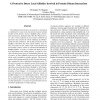Free Online Productivity Tools
i2Speak
i2Symbol
i2OCR
iTex2Img
iWeb2Print
iWeb2Shot
i2Type
iPdf2Split
iPdf2Merge
i2Bopomofo
i2Arabic
i2Style
i2Image
i2PDF
iLatex2Rtf
Sci2ools
BIBM
2007
IEEE
2007
IEEE
A Protocol to Detect Local Affinities Involved in Proteins Distant Interactions
The tridimensional structure of a protein is constrained or stabilized by some local interactions between distant residues of the protein, such as disulfide bonds, electrostatic interactions, hydrogen links, Wan Der Waals forces, etc. The correct prediction of such contacts should be an important step towards the whole challenge of tridimensional structure prediction. The in silico prediction of the disulfide connectivity has been widely studied: most results were based on few amino-acids around bonded and non-bonded cysteines, which we call local environments of bonded residues. In order to evaluate the impact of such local information onto residue pairing, we propose a machine learning based protocol, independent from the type of contact, to detect affinities between local environments which would contribute to residues pairing. This protocol requires that learning methods are able to learn from examples corrupted by class-conditional classification noise. To this end, we propose an...
| Added | 12 Aug 2010 |
| Updated | 12 Aug 2010 |
| Type | Conference |
| Year | 2007 |
| Where | BIBM |
| Authors | Christophe Nicolas Magnan, Cécile Capponi, François Denis |
Comments (0)

